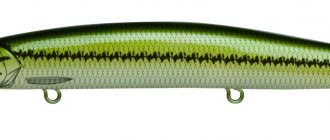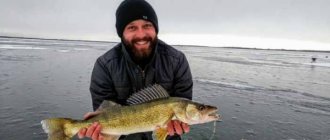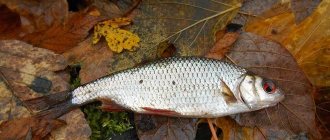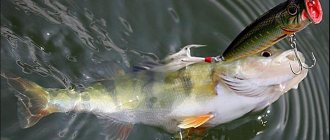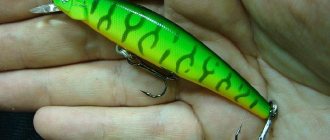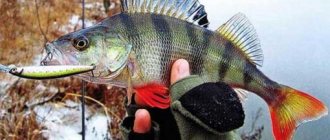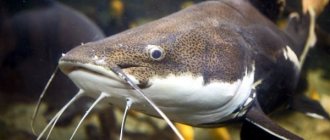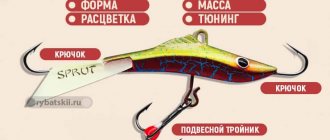For many anglers, crankbaits for pike, shad and small minnows are the main wobblers for hunting toothy fish. Large wobblers are demanding on the characteristics of the rod - they require a fast-action twitch rod with a top weight of 25 grams or more. Small cranks can be used on a regular amateur spinning rod of medium action. In areas where there are few large pike, and the main object is perch, cranks and shads occupy the main place in the boxes of spinning wobblers.
If the basis of your arsenal is large minnows, 10-15 gram shad can also be used on twitching spinning rods with top tests up to 35 grams. Let’s take a closer look at what niche small wobblers occupy when searching for pike. Let's look at the best cranks for pike, which have proven themselves among spinners.
Pike on wobblers
In a separate article about wobblers for pike, large pike minnows are discussed in detail. However, cranking for pike and perch is even more popular - twitching large wobblers is only spreading, as fast rods and large lures have become generally available. Special cranks for pike, especially deep-sea ones, are very massive, up to 20 grams, so they are in the same weight category as rudras and balisongs.
Each angler selects a set of wobblers depending on the conditions in which he has to fish. On edges with currents and large reservoirs, in addition to minnows, large deep-sea cranks work well. In water areas with medium depths there are medium shads, in shallow waters there are surface fish. In pike fishing, cranks are the basis for some anglers, but also as an addition to the set if it consists of twitching minnows.
How to fish with cranks correctly?
The basic movement of the crank is uniform at the same speed throughout the feed. There are two opinions regarding the intensity of fishing line reeling:
- Some recommend feeding the bait as slowly as possible so that it works to the point of failure.
- The latter advise, on the contrary, to rotate the reel handle as quickly as possible so that the crank makes strong vibrations, attracting fish from afar.
Both options have the right to life. You need to constantly experiment with the speed of the retrieve, choosing the optimal one for the given conditions and the mood of the predator. Moreover, depending on the angle of the crank feed, the intensity of winding the cord on the spool changes.
The cranks are unique in that they work stably at different wiring angles. Wobblers can be caught upstream, against the current, across the stream, and are stable when fed in a drift or in an arc. They can be rafted over long distances to promising points, and then driven at the desired pace.
Advice! Shads can be carried out with jerking elements. Unlike many minnows, they catch both on a monotonous serve and on twitching.
Floating models are productive on stop&go fishing, which consists of periodic stops while reeling in the fishing line. At this time, the bait floats up, swaying. This option often works for sluggish, inactive fish. Used for fishing for perch, pike perch and pike. The white predator rarely responds to such animation.
Cranks for pike
To catch pike with cranks, you need larger wobblers than are described in numerous articles from the Internet. Usually several models of popular cranks are listed without systematizing what is needed and why. You can catch a pike randomly with any crank, even small ones for chub and perch, especially if it has a toothy zhor. However, in this article we will consider baits used for catching toothfish purposefully.
- Any wobblers are primarily classified by depth. For example, the abbreviation MR medium runner stands for medium runners with a thickness of 1-2 meters, and SSR Super Shallow Runner stands for shallow water runners with a depth of up to 20 cm. Other manufacturers have numbers indicating depth in centimeters.
- Also, wobblers are assigned prefixes indicating the type of buoyancy - F floating, S sinking, SP suspenders. Experienced wobbler drivers already know this, but for beginners it is advisable to study in more detail the information about the marking of wobblers.
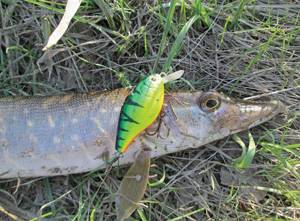
We will not go into details of possible characteristics, but will focus on considering the cranks that need to be used in specific fishing conditions - shallow, medium or deep. Wobblers are a point tool designed for fishing at a certain depth, up to ten centimeters.
There are many cranks, depending on the configuration of the bait’s body. Fats are round and thick, shads are elongated, a transitional stage between cranks and minnows. Flat cranks are flats, similar to small carp. This classification is conditional - for the convenience of grouping baits. The main difference between cranks and minnows is not even in shape, but from the point of view of fishing - the presence of the former’s own bright game on a regular basis.
For minnow, the main technique for pike is twitching, with the addition of uniformity and stop and go if the bait has its own game. If you catch pike with cranks, on the contrary, the emphasis is on uniformity and your game, and jerks and light twitching are additional animation. Therefore, crankbaits are more popular among beginner wobblers - they can be pulled evenly without selecting special twitching gear.
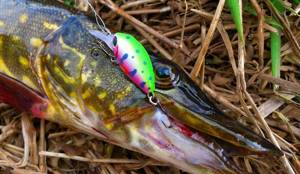
Equipment
- Cranks for pike rarely weigh more than 10-15 grams. Therefore, if the basis of the box is similar baits, the test of the rod should not be much higher. This rod can comfortably work with both large pike shad and medium ones weighing 8-10 grams.
- It’s better to build quickly - the crank will respond better to jerks. However, if you only have a medium-sized spinning rod, then this is enough to try fishing with cranks.
- The cranks work great for pulling and even play.
- Another thing is deep-sea with a large blade. They are stubborn due to the large shovel, and here they need a more powerful river spinning rod, as for large minnows.
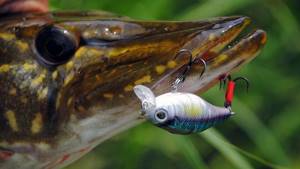
As with other lures, the rig depends on the caliber of the tackle. For barking, you can work with a cord of 0.1 mm; for twitching or deep-sea fishing for trophy pike, it is better to use a thicker and more reliable one, up to 0.16 mm. The caliber of the spinning rod is selected depending on the fishing conditions - and taking this into account, the cranks on it are taken into account. With a stick of 35 grams it will be difficult to work with small rolls weighing up to 10 grams - but it is possible with some skill.
If the basis of the set is large minnows, the spinning rod is selected according to them, usually with tests of 30-40 grams, in order to produce correct twitching. And 10-gram shad in stock will also come in handy, for example, for perch. If large wobblers are not used, a medium caliber, fast spinning rod with a top dough of up to 16-20 grams is more convenient. For long casting and good sensitivity of baits. This is just the thing for khamsins, chaos and flap slaps (more on specific models of cranks and shads below) - light and medium spinning.
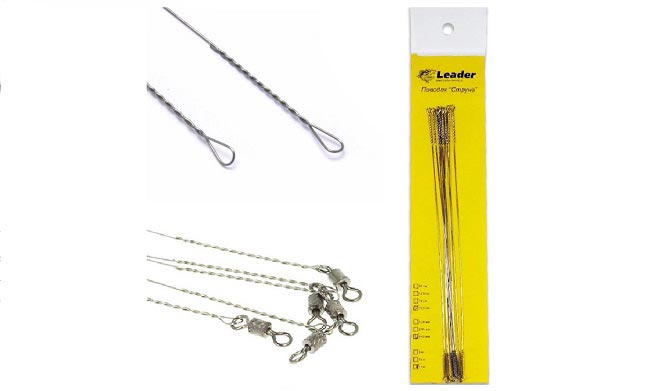
Read more about the correct spinning rod for pike
The correct equipment for cranks - as for any wobblers. A pike needs a metal leash. The best and almost the only normal option is a twisted string, since when using such a leash, the front tee of the bait does not overlap with it. It is better to tie the wobbler through a special knotless installation. The original ring of the crank is removed, and the twist is inserted into the nose ring of the bait.
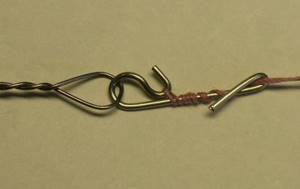
Catching pike with cranks: time and place of use, fishing technique
Catching pike with cranks is successful, both with regular casting from a boat and shore, and with trolling, when the bait moves evenly. And, as we found out, crankbaits are especially good on even retrieves.
Trolling always cranks, minnows don’t work.
There is no consensus on whether it is better to use cranks for active or passive pike. Thus, recognized experts Alexey Shanin and Andrey Pitertsov have diametrically different points of view on this matter. Alexey for active, Andrey for passive. How it went for whom and who believed what. So it is in real personal practice. You can use cranks to catch an active predator and go from zero to a passive one.
Where and when to fish: place and season
Crankbaits are especially effective in warm water - mid-spring to early fall. At this time, cranks collect fish especially well. But this does not mean that they cannot be used at other times of the season.
In spring and summer, grass pike are caught using shallow and medium-depth cranks with different types of buoyancy depending on the conditions.
For deep places, you need deep-sea deep-water crank models; some models with massive shovels allow you to reach depths of 3-5 meters or more. In summer and autumn, when medium and large pike stay deep, deep cranks are especially in demand.
Where else is it effective to use pike cranks:
- Superficial and with shallow depth : oxbow lakes above/along water lilies, nettles, along duckweed; river shallows; coastal vegetation zone.
- Medium depth up to 1.5-2 meters . Along pits and coastal edges. Along oxbow lakes and lakes, when the pike is at half-water. Areas where bays flow into rivers and deep dumps.
- Deep from 2 to 5 meters or more . For fishing river holes, channel edges, deep bays along the bottom.

How to catch: serving and retrieving
A specific bait should be selected based on fishing conditions, fish activity, the horizon in which it stands and weather conditions. The working depth is always indicated on the bait itself. The more passive the fish, the more passive the action of the bait should be, with a large number of pauses and various slow pulls. For active wiring, twitch wiring and its variations are suitable.
Wires that are used when fishing for pike with cranks:
- Basic retrieve - uniform retrieve from lazy/slow speed to fast, depending on the activity of the pike.
- Stop-and-go . Uniform wiring with pauses and/or accelerations.
- Stretches and jerks of different amplitudes and frequencies.
- Twitch variations with pauses and periods of uniform animation.
When fishing from a boat, the following technology gives good results: the angler stands at depth and the deep crank diver casts it right under the shoreline. Thus, as it approaches the fisherman, the wobbler gradually goes deeper and probes the entire coastal edge. We make casts like a fan.
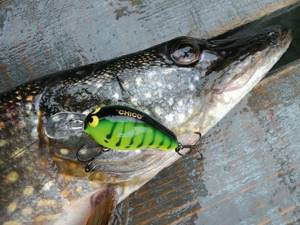
Three success factors ! First: it is important to vary the wiring speed. Sometimes changing speed gives amazing results. Second: it is also important to accurately determine the horizon in which the pike is standing. And choose a crank so that it goes in the same horizon. For example, for bottom pike, you need a wobbler that will literally scratch along the bottom, lose its play and raise mud. Third: the most effective option is to move the crankbait along the bottom of the reservoir, as if studying the relief with periodic strikes and explosions from the bottom during pauses. This works especially well on pop-up models. Many suspenders among the cranks actually turn out to float up slowly - that’s it!
Catching pike with cranks - video from recognized spinning expert Alexey Shanin:
Shads for pike
You open the Internet, and when you search for the best cranks for pike, you see a vinaigrette of wobblers collected in tops and ratings based on incomprehensible criteria. Due to the variety of shapes and sizes, in general, cranks are universal. However, each of them, like any wobbler, is designed for certain fishing conditions.
Therefore, you don’t need to look for the 10 best crankbaits for pike of all times – there are none. It is necessary to select a crank with specific requirements that the angler has understood for his pike fishing conditions - size, buoyancy, and, most importantly, immersion depth.
For some reason, in these hodgepodges of “best wobblers” in incomprehensible articles on pseudo-fishing sites, among which real pike killers are sometimes found, shad are poorly described. All articles are either about large minnows, or about round or pot-bellied crankbaits. But it is shad like khamsin, slap or chaos that are the best and universal killers of pike and other predators in conditions of medium depths and the absence of a strong current, in addition to large minnows. They are also regularly eaten by bersh, perch, asp, and chub.

In articles about large wobblers, they are overlooked due to their smaller size. And in publications about small cranks - since, in fact, they are not cranks in their pure form, but a transitional form between them and minnows. However, it seems that these medium-sized shad are the main bait for pike, and indeed for any predator at depths of up to 3 meters. The basis of the wobbler arsenal is light and medium caliber, in addition to pure minnows of 60-90 mm. And you need to start your review with these killers of pike and perch at medium and shallow depths.
Shads are crankbaits with an elongated shape. The name itself comes from the American shad fish, meaning a small surface fish, something like our small, ubiquitous herring, topfin and bleak. This is a transitional form from pot-bellied cranks to elongated minnows.
It is this body shape that makes these lures unique - they work on pike both on soft twitching and have an excellent game of their own. The oblong body of the shad, flattened from the sides, when moving without jerking, performs stable swaying along the rolling axis, and even more so when jerking, with the body skidding to the left or right.

The fisherman selects and creates the animation himself - the shads work both at high-speed and slow ones. Stop-and-go, light twitch - only add variability to the wiring of such a crank, making it even more universal.
Although I don’t like the terms rating or top among lures, it is definitely necessary to highlight the shads, which are class-forming in this type of wobblers, and have already become a household name, since they are multiplied many times by various manufacturers due to their catchability and popularity among anglers:
- Khamsin-like crank-minnows – in fact, Khamsin shads from Zip Bates, its numerous similar replicas, as well as chaos from Ponton 21 with copies and Tsuribito jerkbait 80 (even though it is officially a minnow).
- Thick big real pike crank shads, like Flap Slap from Megabass.
- It is better to divide the remaining cranks for pike according to depth, into shallow and deep water.
- Just rolls and flats - classic, short with a big round head or short flat. For depths from 0.2 to 1.5 meters.
- Deep-sea cranking for pike with a large shovel.
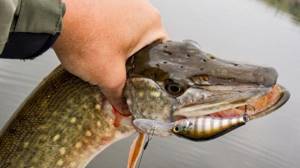
Top 10 best wobblers for pike fishing
Choosing the best lures for pike is quite difficult; it all depends on how much the angler is willing to pay for the lures and whether he can use them correctly later.
The top cranks for pike changes every year, but the 10 best always remain at the top in terms of catchability. Next, we will study the most popular models that are always purchased.
Kosadaka Boxer XS
This baby from a well-known brand is only 40 mm in length and weighs 8.5 g. It features high flight performance, a textured body and holographic eyes make the model as similar as possible to a natural fish.
It dives only 60 cm, but the presence of a noise chamber allows you to attract the attention of a predator even from the depths.
Kosadaka Gemini XD 55F
This fish belongs to the flat subspecies, its length is 55 mm, and its weight is just over 10 g. It is especially attractive to predators due to its noise effects when retrieved, as well as its slow ascent during pauses.
It performs best when twitched; it can dive more than 2 m. It can attract not only the toothy predator of a reservoir, chub, pike perch, and perch will also respond to this model.
Kosadaka Spell XD 50F
Initially, the model was created for angler competitions in catching predators, including pike. Now it can be found on sale in many fishing tackle stores. This predator wobbler is considered weighted, it floats up slowly and has one distinctive feature: the complex profile of the front blade allows you to control the game using the speed of the retrieve.
The bait will perform best when pulled evenly; the noise effect will attract the attention of a predator from afar.
Kosadaka Cougar XD 50F
This bait is perfect for beginner spinning fishermen who have at least mastered even retrieving. You don’t need to make any special efforts to animate the wobbler; it will start playing with minimal skills. The noticeable weight allows you to cast this crank over considerable distances, and the noise chamber will attract the attention of even far away predators.
EverGreen Combat Crank SR
This wobbler is not equipped with a noise chamber, its dimensions are not large, but this does not negatively affect its catchability. The bait is floating, designed for fishing water bodies with a large number of various obstacles in the water column. Works great in snags, on shallows with just rising vegetation, and will pass between water lilies.
The plastic used to produce the bait prolongs the life of the bait; it will help you catch a lot of predators in almost any body of water where they are present.
Pontoon 21 Deephase
Deep sea fish, which is often used for trolling. It goes deep to 4.5 m, but you won’t be able to cast the bait far from the shore. Fishing for depths by casting is carried out from a watercraft or lowered to the required place along the current, which means that this model is one of the few that are used on the current.
Deps DC-400 Cascabel
A large floating model designed for catching large bass. However, our spinning anglers almost immediately began using cranks to catch the toothy inhabitant of our reservoirs.
With the right animation it works great and depicts a fish believably. Powerful tees will allow you to spot and catch even large specimens without any problems. A special feature of this wobbler is its stable play in any conditions, even when using a very thick fishing line.
Halco Sorcerer 68
A model of floating options, it perfectly catches predators at depths of 2 m to 3 m. It can easily overcome small water obstacles, and the action of the bait will not be disrupted.
Experienced fishermen recommend using a wobbler in the summer when fishing shallow water bodies.
Yo-Zuri 3D Flat Crank
A real Japanese will become a thunderstorm for a predator in bodies of water with minimal or no current. The wobbler goes deep a maximum of a meter, works great with even wiring, but others will make it swing quite well from side to side. The acoustic effects created by this will attract even a far-standing predator and lure their ambushes to the relative shallows.
Owner Cultiva Bug Eye Bait
This is probably the best crank for pike; they catch it always and everywhere, the main thing is to choose the right place and be able to place the bait. Deepening to the depth allows you to fish only in shallow waters, and an aggressive twitch is used for bait. Only twitching and sharp jerks will fully reveal the capabilities of this bait in a pond.
The noise chamber will attract additional attention of the predator, and many trophies may not even see the wobbler, but hear its movement.
Rapala is one of the excellent manufacturers of wobblers of this type; their line is simply impressive; it’s simply impossible to describe all the worthy models.
Khamsin and his clones
What we have here is not an advertising rating of pike cranks - but a review of working models. And let’s start looking at specific wobblers with Khamsin, of which there are now many varieties both in stores and on aliexpress. This is an excellent shad for a beginner - you don’t need to come up with special twitching wiring, it works on its own on any spinning rod.
Naturally, the wobbler itself needs a normal one, and not a bad Chinese copy. Among the Chinese there are already khamsins that are not inferior in quality and properties to the original from ZipBates, you just need to know where to get them.
Zip Baits Khamsin 70
It is not for nothing that the original Khamsin from Zipbates is considered by many spinning anglers to be the best crank for pike and perch for small and medium depths. Length – 70 mm, in the SR version with a small blade, weight 9.5 g, depth up to 1.5 m. DR with a large blade – 10 grams, dives up to 2 meters. It works great on passive, wary fish. But when it comes to active use, it’s no worse. There are also micro versions of the crank for perch with a length of 5 cm, but for pike we are primarily interested in the seventy.
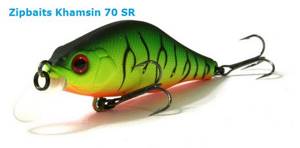
All thanks to the sweeping and wide-amplitude vibrations of the body due to a special balancing system. When moving and twitching, it looks like a fluttering fry. With small pokes you can play almost on the spot. When paused, it is suspended or slowly pops up, depending on the load with the metal leash. Any wiring works - evenly, with pauses, twitching, light jerks with stops or series.
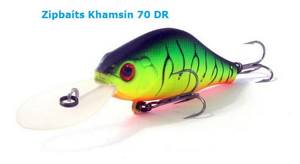
Kosadaka mirage
A high-quality replica of the Khamsin 70 – Kosadaka Mirage XS 70F. 7 cm, 9 grams, depth up to 1.5 meters. The game characteristics are the same, however, the difference is in noise. Large mirages from Kosadaki are noisy, with balls. Only small 5 centimeter ones are quiet. This wobbler is not just a replica, but, one might say, an established independent model. There are almost no external differences. Same for the game. However, with Zipbates costing more than 1,200 rubles, mirage is sold for 400-450.
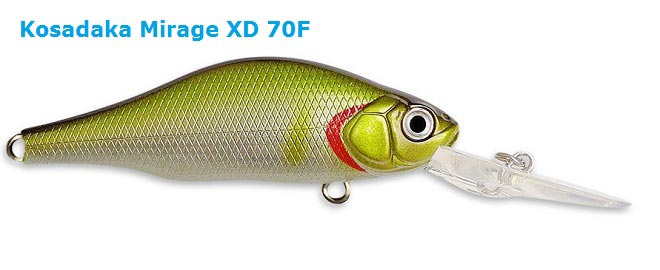
A larger version is Kosadaka Mirage XS 85F, 15.4 grams with a length of 8.5 cm, depth 0.5-1 m. Zipbaits do not have this - this is what the original khamsin lacked. Larger shallow water fish. XD version with large blade - with a depth of up to 2.5 meters. There are also babies 5 cm long. All options are working no worse than the ancestor from Zip Bates.

The best copies of khamsin from Aliexpress
Naturally, this killer crank for catching pike and other predators has already been copied 100,500 times by less famous Chinese than Kosadaka. And some did it no worse, and at the same time cheaper. The most worthy copy of the khamsin, which has already been tested by many anglers, is from the Count Bass store. Even cheaper than Kosadaki and the quality is the same as the original from Zipbates, much better than the TsuYoki Hump 70SP copy that can be found in retail stores.
The rest of the copies from Ali to this wobbler are rather replicas of the Kosadakov mirage, as they are noisy, with balls. Countbass khamsin is quiet, with a magnet, just like the original. The quality of painting and fittings is even better than that of the sensational Berking replicas. But it won’t be possible to completely compare - Berking doesn’t make copies of Khamsin yet.
High-quality quiet replica of Khamsin from Countbass: https://ali.pub/4alttd
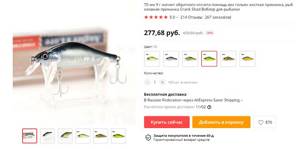
Noisy, verified copy of the Mirage 70 (noisy khamsin): https://ali.pub/4altux
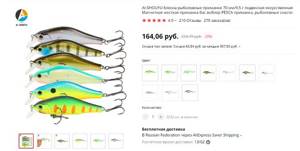
A cheap copy of Khamsin is also working: https://ali.pub/4cstkk
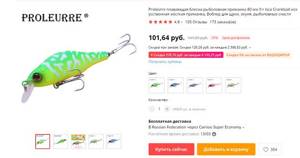
Tips for choosing cranks
Having studied the rating of cranks for pike, everything seems to become clear, but in practice it often turns out that this is not entirely true. When coming to a store or opening any of the sites with spinning baits, in particular wobblers, even an experienced fisherman can become confused. The huge selection and variety of models does not always make it possible to make a choice, so you need to know a few secrets of choice, which no one can do without:
- It is worth understanding that a high-quality crank from a well-known brand cannot be cheap;
- It is not advisable to buy Chinese cheap copies, their game will differ significantly from the originals;
- You should immediately look at the depth, so that later the bait does not have to simply take up space in the box;
- the color is selected depending on the time of year and the transparency of the water: in muddy water it is better to use acids, but after the dirt has settled, use products with a natural color;
- For casting fishing, it is better to use sinking models, especially if the predator is inactive.
For the rest, fishermen should rely on personal experience and sympathies. They say if the spinner likes the bait. She will definitely catch it.
Pike cranks are used by many spinning anglers both for casting and for trolling. They will always catch, the main thing is to use the bait correctly and choose the most catchy one for a given body of water and time of year.
You can ask your question to our author:
Pontoon 21 Chaos and working copies
The next killer crank for catching pike, or rather shad, is the Pontoon 21 Chaos 72 SR and DR. It differs from khamsin in having a more protruding belly. This is a wobbler for the same conditions as khamsin. However, the game is already different - the chaos is not so hunchbacked, thicker and more driven, that is, closer to minnow.
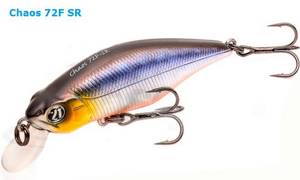
The weight of the SR version is 9.3 grams, the depth is 1-1.2 meters. DR – 9.8 gr., 2-2.5 meters. Chaos is more stable in the current due to its less high body, but in terms of play it is the same khamsin.
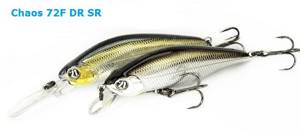
The original costs about 500 rubles; you can also find decent working replicas on Aliexpress:
Chaos with aliexpress Mister Charles - high-quality replica: https://ali.pub/4alu2p
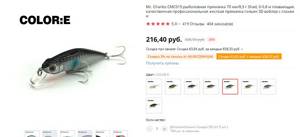
Cheap chaos, but larger - 90 mm, also working
https://ali.pub/4alu67

Crank classification
Cranks, like any artificial spinning bait, can be classified according to different criteria:
- according to form;
- by depth;
- to size;
- by buoyancy.
Classification of rolls by shape
Based on their shape, all crank wobblers can be divided into three large groups. This parameter determines the scope of application of the bait, the features of fishing with it and other subtleties, knowing which, the angler can use it as productively as possible.
- Fat. Translated as “fat man.” The most massive group among cranks. These are universal wobblers, suitable in any conditions. They hold the current perfectly and do not lose their play when moving across the stream. They are distinguished by impressive long-range properties and noisy aggressive behavior, attracting predators from afar.
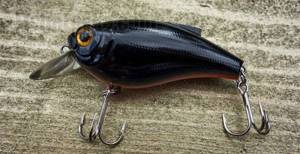
Photo 1. Seductive fat man - fat.
- Flat. They have a flat body. The vibration frequency during wiring is average. They are not so stable in strong flows, therefore they are recommended for slow flows or standing reservoirs.
- Shad. Translated as "herring". Many models in this group are a kind of symbiosis of crank and minnow. The bait allows for different animation techniques, including jerking elements. Can work on currents and in closed reservoirs.
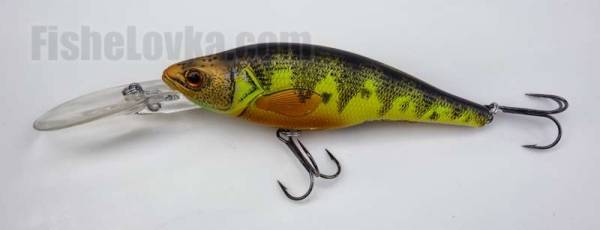
Photo 2. Shad has a slightly elongated shape.
Important! In some classifications of wobblers, shads are considered a separate class of bait, along with crankbaits and minnows. This is not a mistake, but the opinion of many anglers. Moreover, the essence does not change.
Classification of cranks by depth
In terms of depth, crank-class wobblers, like other bulky solid baits, are:
- superficial (designated SSR),
- subsurface (SR),
- deepwater (MR, MDR, DR, DDR).
Classification of rolls by size
By size they can be divided into:
- ultralight;
- light;
- average;
- large.
The latter, by the way, are not so many. They are used primarily in trolling fishing in vast water areas, designed for impressive depths and weighty trophies.
Classification of cranks by degree of buoyancy
According to the degree of buoyancy, cranks are:
- floating;
- drowning;
- suspenders (very rarely).
The first ones are the most common and are used everywhere. The latter are used in currents because they better maintain a given horizon in a strong current. There are few suspenders among this class of wobblers. Mostly these modifications are found among shad, which can be twitched like minnows.
Tsuribito Jerkbait 80 – almost a minnow
Wobbler Tsuribito Jerkbait 80F - the same as Chaos, only larger. About the same as Mirage 85 is larger than Khamsin 70. The body shape is almost the same as that of chaos, but for some reason it is officially considered a minnow, and not a crank shed.
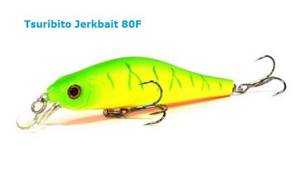
Sure, the larger Tsuribito Jerkbait are pure minnows, but the 80 F is as humpbacked as chaos. The game is the same, any animation methods. But twitching can be done more aggressively. Weight – 8.1 g with a length of 8 cm, depth – up to 1 meter. Same niche as Mirage 85. Pops up relatively quickly.
High quality copy from Mr. Charles: https://ali.pub/4aluah
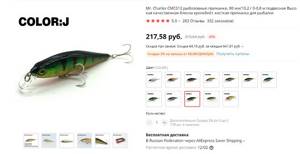
Main difference
Cranks have a more active game. This type of wobbler has a large head and a small body. The features of this form make it possible to imitate a small, well-fed fish, which in any case will fall into the field of view of the pike and provoke the predator to attack.
Despite this, cranks have their own classification. That’s why they are divided into three types: shads, flats, fats .
- Shad are the most popular bait today. This is due to their large selection, which makes it possible to choose bait for different fishing conditions. Most models resemble herring in their parameters, but there are baits that imitate completely different predator prey. Most often these are small animals and insects.
- Flats are characterized by a flatter, unchanged body shape. Due to the design features, these wobblers have an average vibration frequency and amplitude. However, not all cranks can withstand water pressure, so it is advisable to use them in weak currents. The best crankbaits for pike can withstand fishing for large fish, which is not typical for these small wobblers.
- Fats with a significant volume are distinguished by a short body. That’s why they have an almost rounded body shape, which is why fishermen call them “fat ones.” The majority of models resemble insects and are therefore used for seasonal fishing. Moreover, large models are universal, as they look like a fish.
Flap Slap and copies from Ali
Unlike the fry discussed above, Megabass Flap Slap is a classic pike crank shad, thick and with a large head. The old version of the crank surfaced. The new Flap Slap LBO is a classic suspender with a long casting system. On a regular basis it gives powerful wide vibrations, on short, neat twitching it rushes from side to side and makes a pronounced rolling.
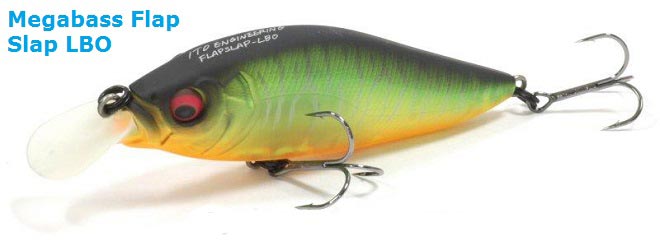
Deep sea version with a large blade - Diving Flap Slap. An ordinary slap weighs 10.5 g, length 7.7 cm, dives up to 1 meter. Deepwater version – 12.4 grams with a depth of up to 1.8 meters. The price, like all megabass, is more than 1200 rubles.
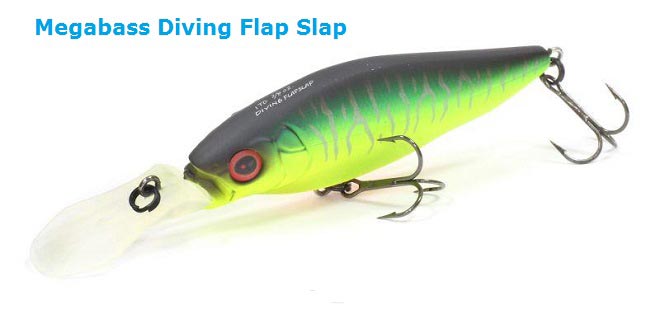
Replica Kosadaka Inborn XS 75F is a smaller copy of the crank. 7.5 cm, 12.3 grams and surface depth 0.4-0.8 meters. The animation is the same as the original.
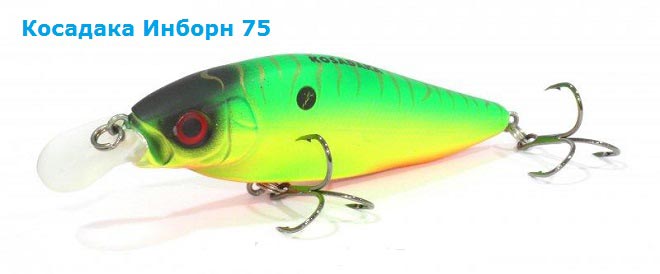
Working copy on Slap with Ali: https://ali.pub/4aluds
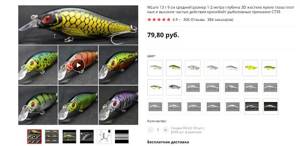
Fishing club "Samson"
This type of wobbler is an outsider in popularity in our country. Very often, the wiring of a crank is compared to the wiring of a rotating spoon - cast and evenly rotate the reel handle. They are less often carried out with heavy rods or stop&go style, but a crank is not just a pot-bellied wobbler. Thanks to their shape and compact body, these lures with any type of blade create a powerful vibration. The resulting mechanical (including acoustic) waves propagate over a long distance, attracting the attention of fish from a distance far from the course along which the crank is moving. That is why it is generally accepted that wobblers of this type are ideal for quickly finding predator sites when you need to explore a large area of water. The search tactics are quite simple: casting and quickly moving a wobbler in a layer of water where the presence of predatory fish is possible. When the bites begin, the crank is replaced with another bait, often a minnow wobbler, which works well in local spots. It turns out that they find fish with a crank, but they catch them with a minnow. This is in theory, but in practice it is often different.

Carnivorous fish are attracted to the object by its unpredictable, unusual movement. A strongly vibrating crank, rushing at high speed with a uniform retrieve, can attract the attention of an active predator. And if the fish doesn’t mind having lunch, but is lazy (for example, in the summer heat), you need to offer it something special, non-standard. Let me digress a little from the main topic, I have been diving since childhood. Over time, my childhood hobby grew into a professional activity, and seven years ago I became an instructor at an international diving school and now help people explore the underwater beauty of the sea. What does this have to do with cranks? None directly, but thanks to my acquaintance with the fish’s habitat, I got an excellent opportunity to study their habits more closely.
During one of the night dives in the Black Sea, I noticed a very interesting way of hunting scorpionfish (sea ruff). This bottom-dwelling fish is an active nocturnal predator. It is rare to see a scorpionfish during the day, and even then it is in a sleepy state. And at night, sea ruffes have a real feast: they lie on the stones, taking their shape, and wait for the victim to swim or crawl past (crabs are their favorite delicacy). When I went under the water, I saw a lot of small fish that looked like anchovies. These fish, as the light of the lantern approached, scattered in different directions, and some, blinded by the lantern, immediately crashed into the bottom, where scorpion fish lay in wait for their prey. This is where the instinct of a predator in choosing a prey manifested itself: the fish swimming past almost did not attract the attention of the ruffes, and those that crashed into the stones were eaten instantly. This is one example of unusual behavior of creatures in nature. Reproducing this behavior with artificial bait was not difficult, especially with a diving crank. To do this, you need to deepen the wobbler to the very bottom, and then move it so that the bait periodically plows the soil with a blade. This method can be called the most universal, with its help I achieved excellent results while fishing in different places on the planet. The most striking incident, perhaps, occurred quite recently at the Cheboksary Reservoir during the filming of a film about twitching with large minnows. This Volga reservoir is rich in snags. Typically, Texas rigs work well in such “dead” places, but in some areas where there is 2-3 m of free water space above the snags, large minnow wobblers have no competition.
The B-Switcher family of oblers from Zipbaits.
But neither the Texas rig nor the minnow produced any results. I didn’t even think about cranks at that moment; I followed the director’s instructions to fish with large minnows. Finally, the director himself, unable to bear the lack of fish, picked up a spinning rod, attached a deep crank and began to regularly take large perches out of the water. Paying attention to its wiring, I noticed that the bait somewhere in the depths was constantly moving from branch to branch, without catching them with tees. Bites occurred exclusively at moments when the wobbler was in contact with snags. Thanks to its compactness and almost vertical position of the body when guiding, the crank can easily pass almost all obstacles. But snags still happen from time to time, so uncoupling is necessary. The pike didn’t take long to arrive either. She swallowed the bait so deeply that she had no chance of escape. This is understandable; from a predator’s point of view, a compact crank is very convenient for “precise aiming.” When guiding it through snags, special attention must be paid to the smooth manipulation of the tip of the spinning rod. Almost always, before the wobbler touches the branch, a characteristic tension and a slight hum are felt through the rod, which indicate that the line is rubbing against the branch and you need to be prepared for contact with the snag: do not make sudden movements; the wobbler should gently touch the branch. This is quite enough for the predator to pay attention to what is happening. A healthy fish full of strength will not easily hit the branches. And the sluggish behavior of the wobbler indicates that the fish is disoriented, unable to control its movement, it will not be difficult to overtake it, and the “wounded animal” immediately becomes a victim of a predator. With this style of fishing, not only the crank, but also the fishing line comes into contact with obstacles, so I advise you to pay special attention to its abrasive resistance. Of monofilaments, fluorocarbon is preferable for these conditions, which is much stronger than nylon. When choosing a braided fishing line, pay attention to the presence of a durable, abrasion-resistant coating.
But let's get back to the wobblers. Crank works effectively not only in snags, but also on the edge of sharp slopes. In such places, I most often position the boat so that the bait moves from the shallows to the depths during retrieval. If, for example, the depth at the top of the dump is 3 m, I use a wobbler with a depth of up to 3.5-4 m. This bait reaches the bottom layer very quickly. When the wobbler descends to a given depth and begins to actively cling to the bottom, I significantly reduce the rotation speed of the reel and add alternating short and long jerks to the retrieve. The task is simple: select the retrieve speed, as well as the strength and intensity of the pulls so that the wobbler does not “plow” the bottom too much, but at the same time it was not much higher than him. Such behavior of a wobbler is quite difficult to imagine, but I managed to film it underwater, in the place where these baits are most appropriate.
Crank works effectively not only in snags, but also on the edge of sharp slopes.
So, the key point when fishing using the methods described above is contact with an obstacle. The behavior of the bait at this very moment determines the reaction of the predator: whether he decides to attack it or not.
The Suslon crank family from Megabass.
Lures. I will name some of the most effective crank models. First of all, this is the Cyclone Megabass family of wobblers. They are characterized by four features:
• there are three versions of Cyclone according to the degree of depth, so it is easy to choose a wobbler for any conditions; shallow (SR, shallow runner), for medium depths (MR, medium runner) and medium-deep water (MDR, medium-deep runner);
• thanks to a special device on the back of the belly (chamber with a through hole), these cranks hold the wiring stably;
• they begin to work at a minimum wiring speed, and very actively;
• do not stop playing even when they touch an obstacle. According to Megabass, this is achieved thanks to a special balancing metal plate placed inside the wobbler.
I can’t decide how important each of the above characteristics or their combination is, but the Cyclone Megabass does its job “excellently”. Another series from another equally well-known manufacturer that is worth paying attention to is B-Switch-er ZipBaits. It includes five baits, four of which are suitable for the conditions described (the fifth model is a pure subsurface B-Switcher SSR, which is created for other purposes). B-Switcher 1.0 is good for fishing at a depth of up to 1 m; The B-& Switcher 2.0 and B-Switcher MDR Midget are designed for depths of 2m or slightly greater. I use Midget in cases where a smaller bait is required, for example, if the object of fishing is perch. And for depths greater than 4 m, the absolute favorite is B-Switcher 4.0.
Panacea super deep dives for extreme conditions.
All B-Switchers have the proprietary Zipbaits Mag-Drive system to increase casting distance, so they fly very well for cranks, including the B-Switcher 4.0, which has a large sailing blade. These cranks are extremely stable when retrieved, and their play does not falter even after a hard contact with the bottom or an underwater obstacle.
In places where depths exceed 4 m, you need “deep-waterers” such as Deep-X 300 Megabass or Panacea cranks (this is a separate division of Pontoon21) Fat Marauder and Shad Marauder. The choice of such wobblers is of little justification when catching ordinary predators, but if you intend to catch a trophy specimen at the fishing site, then why not try “pig-fighting”.
It must be remembered that when using relatively large deep-sea wobblers, rods of increased power are required, which allow you to cast heavy baits well and not “fall through” during retrieval due to the high drag of the wobblers.
Rod. It’s worth talking in more detail about rods for crank fishing. If you fished with these wobblers occasionally or used them as a “search engine,” then there was no need to think about the type of rod. But if you are going to fish with cranks and do it at a decent level, then the rod must have certain properties. In order to understand what is happening near an obstacle and at the moment of contact, the spinning rod must have a fairly active tip, be sensitive, and elastic to the required extent, allowing you to “hold” ' frontal resistance of the crank, but not too “hard”, otherwise there will be a lot of slips when fishing, especially if you chose a braided line. In countries where largemouth bass (bass) live, the use of crank-type wobblers is not uncommon (as in our country), but a pattern, so choosing the right one among the “bass” rods is not so difficult. However, such spinning rods are most often single-piece, and for the domestic fisherman this is unusual and often inconvenient. But there is a choice. Among the models of the new St,Croix Legend Tournament Europe series there are two two-piece models LTES70MLMF2 (lure test 3.5-14.0 g, line test 4-10 lbs, Mod-Fast action) and LTES70MMF2 (lure test 7, 0-21.0 g, line test 6-12 lbs, action - ModFast). Both rods have a length of 213 cm and are designated Cranker, that is, they are intended for fishing with cranks. Of the new products that I have been catching lately, I would like to highlight the Seven&Half Rop-toon21 series. These spinning rods avoid vulgar rigidity, they have a quick reaction, which is much more valuable. Of the models suitable for fishing with cranks, I would like to note the model 764MF (length 228 cm, bait test 5.0-17.5 g, line test 5- 12 pounds, Mod-Fast action), which is called Plug Manipulation, that is, it is designed specifically for manipulating wobblers. The tip of the rod is somewhat softer than that of the St.Croix models, so it is well suited for working with baits smaller than those indicated in the test range, weight, and these can be not only cranks, but also equally persistent rotating spoons, as well as spinnerbaits. And Pontoon21 pays special attention to such a characteristic as holding fish when fishing.
The mentioned gear, of course, is not the only one whose parameters are suitable for the described style of fishing. Each angler has his own preferences.
Setting up the bait. Quite often, on the packaging or in the insert for the wobbler there are instructions on how to adjust the bait so that it does not fall over when retrieving. Basically, these methods are known to most fishermen. If the wobbler begins to “fall” to one side during wiring, then the metal fastening loop (by which the wobbler is tied to the fishing line) is carefully bent in the opposite direction with pliers. If after this the bait begins to “fall” towards the hem too clearly, then the loop is bent back a little. This is how the stability of the bait is achieved through experimentation. “Manual tuning” has to be used for almost all baits, but still much less often for wobblers from serious companies.
On reservoirs, especially on artificially created reservoirs, there are many hydraulic structures: dams are accompanied by concrete walls in places where water drains, concrete walls are adjacent to bridges, bridges have piles, there are berths, etc. There is plenty of fish in such places, but fishing is often prohibited there. However, not everywhere and not always.
In addition to artificial structures, there are also similar in nature, for example, pillars sticking out of the water or tree trunks remaining after flooding. If you carefully study the reservoir, the chance of finding a place with underwater obstacles is quite high.
Let's assume you managed to stand along a concrete wall and start fishing. With a little luck, you will have a catch, since there are usually fish in such a place. But you can significantly increase the result if you “frustrate” the crank game. If the wall is to your left, bend the fastening loop also to the left, then the wobbler will move towards the wall when inserted and hit it with its blade. You will get the effect of this tapping quickly. In the same way, by bending the loop in the desired direction, you can force the wobbler to touch a lonely pole when wiring. Of course, if you constantly “reconfigure” the crank in this way, it is unlikely to last long. The loop may become loose or fly out. But this method itself is worth trying, and then deciding how sad it is for you to shorten the life of the bait in exchange for more productive fishing. You also need to remember that a “reconfigured” wobbler partially loses stability when reeling. After all, its manufacturers sought a certain conformity of shape and details, which you changed. Therefore, the “tuning” wobbler will have to be carried out at a lower speed than recommended, since when the wiring is accelerated, it will go into a tailspin and fly to the surface. This means that the crank must initially have a good game even at a minimum wiring speed. In general, with a little skill, it is not difficult to determine the speed limit after which the wobbler becomes uncontrollable, which is felt on the rod. I checked this on the models I mentioned above.
Perhaps someone will think that all this is unnecessary “absurdity”. I don’t argue, because everyone has their own “basic pattern” of wiring and their own attitude towards fishing. I am curious, prone to different fishing experiments, and I am sure that there are many like me.
original article
Cranks
For catching pike on surface cranks up to 1 meter, standard tadpoles and flat flats are useful. These are shallow water crankbaits of the SR Shallow Runner class. The quality requirements for lures are lower here - both expensive originals and cheap copies work. The main game of a surface crank for pike is pulling and evenly, occasionally twitching. These wobblers are not intended for twitching. However, it is useful to try to animate clean rolls in small jerks.
Kosadaka Boxer
The classic fat crank is short and round. Gives amplitude play at regular intervals and stop and go. Saves the game in strong currents. XL with a depth of 0.5-1.2 meters weighs 11.3 grams, while the length is 50 mm. Kosadaka Boxer XS – even smaller, 4 cm, 8.5 grams, dives no deeper than a meter. A common representative of round-headed short cranks, which pike also sometimes take. Compared to khamsin-like cranks, these are more resistant to currents, as they do not have a high, flat back.
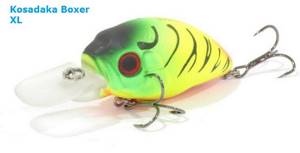
Yo-Zuri Hardcore WO-B-RU
A relatively large crank wobbler for pike Yo-Zuri Duel Hardcore WO-B-RU 0. This is a different shape type - an elongated body tending to the shape of a shad. With a length of 6.5 cm, it weighs 8 grams. and goes down to a meter. The scope of application is the same - evenly, stretching with pauses at the appropriate depth over uneven surfaces, snags, and near thickets.
The described Boxer and Wobb are bright representatives of a whole family of crankbaits, of which there are hundreds of models. When wired, it starts immediately, the vibration is felt in the hand - that means it’s good. An active pike or perch will take it. For passive fish, it is better to invent some kind of animation variation with the shads described at the beginning of the article. The Chinese have a million of them on Ali for 40-70 rubles. We are looking correctly, according to reviews - an article on how to look for working wobblers with aliexpress to help.
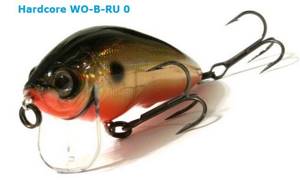
Yo-Zuri 3D Flat Crank
But this baby flat is individual. Yo-Zuri 3D Flat Crank is a killer crank wobbler for pike. The play due to the flat body and step blade is unique, and it is not stubborn. The animation is a cross between shad and fat. At a steady pace, it wags its rear end like a crank. When jerking, it moves its sides like a khamsin.
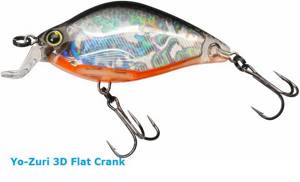
An excellent crank wobbler for pike and perch, when the predator does not take it at a steady pace and you need to come up with jerks or pauses. With a length of 5.5 cm, it weighs 7.5 grams and goes up to 1.2 meters. On a clear bottom with a depth of less than 1.2 meters, it is useful to knock your nose on the bottom, especially when fishing for perch. A strong spatula allows you to do this carefully. It is better to use in quiet creeks, oxbow lakes, ponds or along the edge of reeds, where there is no strong current.
Cheap working copy of Flat Crank from Aliexpress: https://ali.pub/4aluig
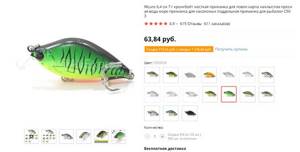
Crank fishing: equipment
In terms of equipment, crank fishing is not at all similar to jig fishing. Hypersensitivity is not required here. The ability to cast sailbaits is important. Build: medium-fast. The spinning rod must have excellent throwing characteristics and great power.
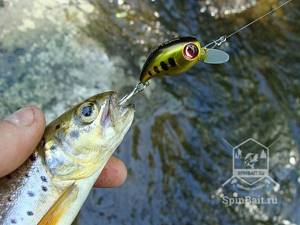
Trout caught on a crank
Which cord should you choose? The question is not as simple as it might seem. If the terrain is poorly studied, then give preference to a sensitive braided cord. Do you want to throw a wobbler to the maximum possible depth? Take thin braid.
Those for whom natural wiring is important should trust monofilament. Today, by the way, a worthy alternative has appeared that does not involve a painful choice - fluorocarbon.

A low-profile baitcasting reel will allow you to cast bait over long distances. In addition, it is reliable and durable. If there is none, then you can get by with the usual inertia-free one.
Deep-sea cranking for pike
The next group of cranks are deep-sea baits for fishing large areas of rivers and reservoirs with depths of more than 3 meters. These are DR Deep Runner wobblers. The deeper they are, the more suitable they are for trolling rather than spinning. A large shovel gives these cranks a lot of tenacity.
- You will need a powerful spinning rod that can withstand this. Deep minnows can be chased with the same gear as for large pike minnows, on a spinning rod for twitching with a top weight of 35 grams and a fast action. It won’t work on light due to stubbornness.
- The usual scenario is to place the boat above a dump, at the exit of a hole, along bottom irregularities at depths of over 3 meters, above snags with a layer of water above the branches corresponding to the depth of the crank. In driftwood, of course. You need to accurately understand the horizon of the roll's passage so as not to leave it in the rubble. At the same time, the diving depth is affected by the water temperature and the thickness of the cord - this also needs to be taken into account.
The conversation with the tops and ratings of the best deep-sea cranks for pike is short - they don’t exist. It all depends on the conditions of the reservoir and the hands of the fisherman. Let's look at some models that catch many fish, without allocating strange places on the pedestal.
Kosadaka Cougar XD
Cougar is a replica based on several branded cranks. The result was a working independent bait. With a length of 5 cm, it weighs 10.9 grams and goes down to 2.6 meters. Works on fast wiring with twitching. This is a transitional stage from shallow-water cranks to deep-water ones.
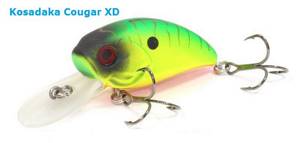
Yo-Zuri 3D Crank
With a length of 6.5 cm, this deep-sea crankbait weighs 17 grams. Pure deep crank with a depth of up to 3.6 meters. This is a formative type - a further development of deep Rapala cranks. It is copied and replicated by all and sundry. A standard classic representative of the family that catches. Working stroke - evenly with pauses, touching the bottom with the blade. In addition to pike, large perch, pike perch and catfish are caught on it.
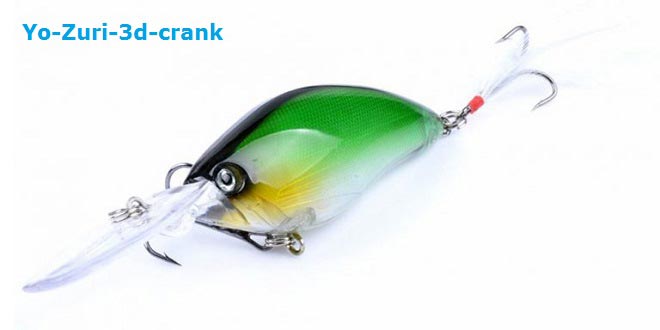
Rapala Shad Rap RS
Made based on the representative of the old school - the famous Rapala Shad Rap. This wobbler is a suspender, at 7 cm it weighs 1 gram, and goes deep up to 4.5 meters, depending on the model. At any fishing speed it produces a stable wobbler; it can be used both in spinning and trolling.
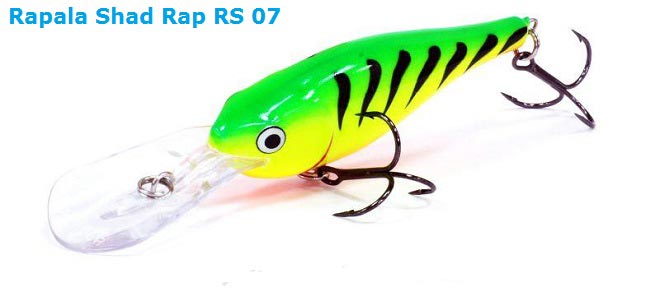
Evergreen Kombat
Deep-sea Combat is known to experienced spinning anglers who fish with deep cranks. The series includes several models - 250, 320, 480. The deeper the water, the larger the blade, and the more they are designed for trolling.
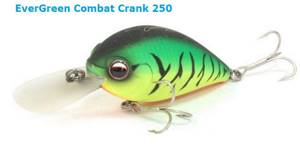
However, a fairly powerful spinning rod with a powerful reel will pull it. It is better to fish from a boat, since with such depth you will have to scoop the edge from the shore with a shovel. Plus, shore fishing with such cranks is fraught with losses.
A working copy of Evergreen Kombat 320 from Berking for 240 rubles: https://ali.pub/4alv32
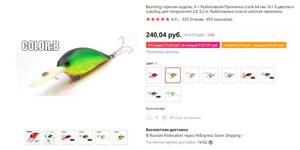
Halco Sorcerer
The Hulk is specially made with a powerful blade, and a replaceable one - for this purpose. So as not to be afraid to hit the bottom. Depending on the size of the replacement blade, the depth also depends. Large models are more designed for trolling; the Halco Sorcerer 68 is better suited for a medium spinning rod.
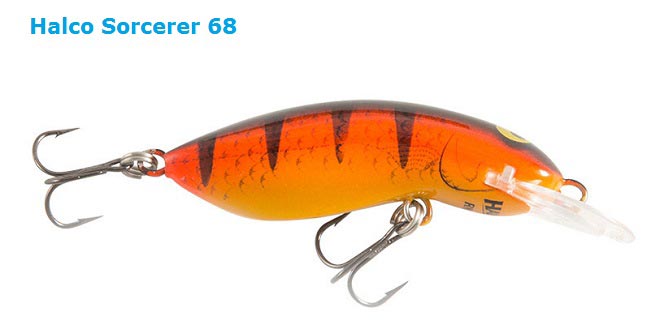
Working copies on Ali: https://ali.pub/4alvb8
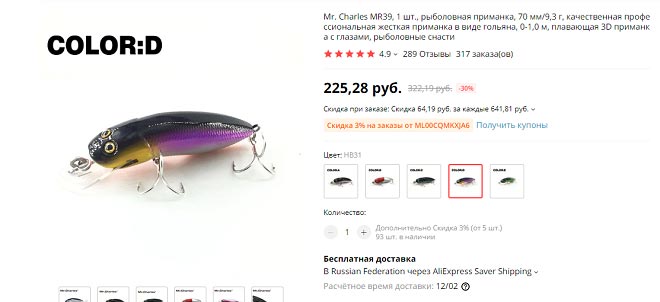
Subscribe to the channel:
YouTube channel RYBAFAN
We are VKontakte
How to choose a catchy crank for pike: general characteristics, 10 best
Let's look at the main characteristics that a pike crank should have:
- You should select cranks with a massive shovel and body, as well as relatively small anchors. Pike often have to be caught in snags, among stones and along edges. To minimize the number of hooks, as well as the likelihood of breakage, crankbaits with the stated characteristics should be selected.
- Cranks with high-amplitude and medium-amplitude active play are more in demand. This is exactly the kind of game the toothy beast loves.
- Workmanship. Everything is simple here - low-grade Chinese and/or their ilk work poorly and do not live long in sharp pike fangs.
- Equipped with a long-distance casting system.
- River pike often stands at the edge of different streams. Therefore, the crankbait must be able to withstand the current and its changes well, both in strength and direction. Don't fall on your side.
- Different wobblers required for different working depths. Working well at depths of 0.5-1; 2-3+; 4-5 meters.
- You need quiet and rattling crankbaits. Noisy to collect active fish, quiet for passive ones.
- Cheap cranks usually catch worse than proven, but more expensive ones. The reasons are still the same. They don’t hold the jet, the game fails, they fly poorly, the degree of vibration differs from copy to copy, poor quality of materials and, as a result, loss of performance characteristics after one or two bites, etc.
It is necessary to have cranks - from surface ones for catching grass on flood lakes and oxbow lakes above kushvinka and nettles, to deep models for fishing edges, dumps and holes.
For muddy and deep water, acidic and bright colors are used, and for clear water, various natural colors are used. In practice, fishing often results in a sharp change in the color of the bait. That is, we train a pike to attack with a crank in one color, then we put another in a completely different color (natural/acid, yellow with red/green with black, etc.). This often provokes a passive pike to attack.
TOP 10 cranks that are worth having for pike fishing (in the must-have set we will include different types of cranks from different price ranges - according to everyone’s preferences and budget):
- Wobbler OSP DUNK Suspend. depth is 0.5-4 meters, which is a very good indicator for a 5 gram bait. Deep crank of small shad type (Western European herring). Very aggressive game on the retrieve. You can literally dig the edge along its slope. It has a very powerful and strong shovel that can withstand the aggressive effects of sand and stones. A massive shovel and a large inclination of the bait when retrieving allows it to play the role of a non-snagging bait in strong places. Very good for bottom pike. In this case, the wobbler is driven with scraping along the bottom and pauses for a small separation from the bottom (but there is no need to plow the bottom!). Thus, the angler seems to study the bottom topography on each cast. The bait sets wide glides when retrieving and creates a flickering effect, which, in principle, is not typical for shad-type crankbaits. But OSP Dank is an exception.
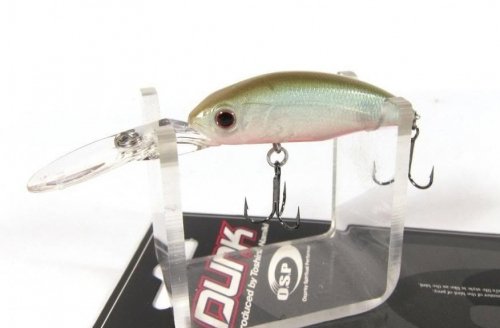
- Daiwa Tournament SPIKE 53SP. The shape resembles OSB Dank, but is twice as expensive: 500-600 versus 1200 rubles. Has a long-distance casting system. Sets wide and low-frequency glides that can stir up even a passive pike and bring it out of its stupor. Recommended depths are 2.5-4 meters. It is good to fish edges, pits, dumps, and point elevations at the bottom of the reservoir. You need to start driving the wobbler to the required depth 5-10 meters before the promising location. Postings - stop-and-go, uniform, wavy, chaotic twitching.
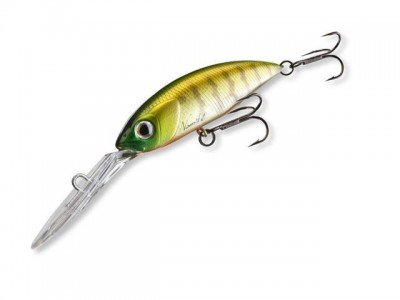
- Evergreen CC Predator SP. 7.5 g, 60 mm. There is a long-distance casting system. A good but expensive shad from Evergreen. Working horizon up to 3 meters. Has a higher frequency game than Daiwa Spike. The glide amplitude is smaller. It’s good on twitch, if you select the right strength, the jerks will spin almost in one place, like a loach in a frying pan. For pike, the crank is good on a combination of uniform and twitch retrieves, where there is a pause of 2-3 seconds between animation variations.

- Kosadaka Kurado SH 60F; XL 60F; DD 60F , 7.5 grams, 60 mm - a series of budget crank wobblers, the line of which covers the depth range from 0.5 to 4 meters. Depending on the model, you can “mow” pike grass evenly across the surface and in half-water, or tap the bottom with a deep model in search of a trophy. One of the downsides is that it is quite demanding when it comes to wiring, since if the twitch is sloppy, it gets lost in the game and falls to the side.
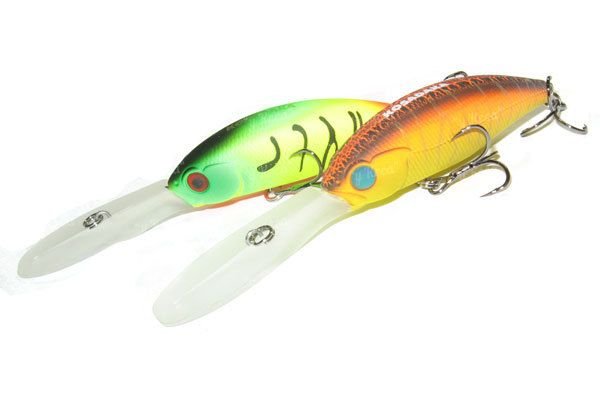
- YO-ZURI 3D Flat Crank, 7.5 grams, 55 mm. One of the most famous flats. And there are stories about the color “Grey-haired” (pictured) - the gray-haired one mowed down the entire harvest on the lake, without the gray-haired one there is no point in going fishing, etc. Noisy and floating. 3-D technology from YO-ZURI - relief holography inside the polycarbonate case shimmers with all the colors of the rainbow. It looks a lot like a wide-bodied fish - silver bream, blue bream, crucian carp. Slow and regular with pauses and slight movements during the pause. Yuzuri 3D flat crank does not require any special Twitch skills and is suitable for beginners.
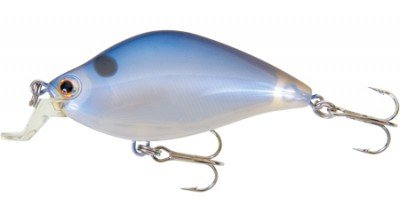
- Jackall Bling . 55 mm, 9.3 grams. The weighty Dzhakalovsky crankbait is good for pike and large perch. stop & go, Of the recommended types of animation - short pokes and pulls, monotonous uniformity is often the best option. It collects pike very well from a depth of up to 4 meters at a regular level, with a real depth of up to 1.5 meters.
- Lucky Craft Moonsault the entire model range is from 5.5 to 6.2 cm, from 8.2 to 14.6 grams and from 0.1 to 4 meters depth. A little-known but very successful crank. A balanced crank with an interesting sound effect of sand being rubbed between the palms. Wiring options include easy twitch, uniform or stop'n'go. It floats up slowly when paused, which can be used on a passive pike.
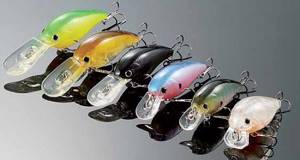
- Jackall Cherry 44 and jackall Cherry dd. 5.5, 11.2 grams weight. Medium-deepening universal and deep versions of the famous wobbler (perhaps after the chabik) from Jakal. The main wiring is lazy, uniform and even with pauses. The bites are mostly on pause. 44 model for medium water, deep water is good for hitting along the bottom of the edge and dumps. A very sweeping and noisy game. It collects fish well from a distance and in muddy spring water.
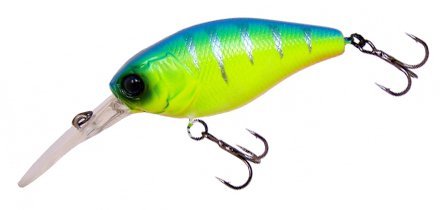
- ZIPBAITS Khamsin. 7 cm, 9.5 grams. It has a long-distance magnetic casting system, very catchy. Khamsin is very easy to operate - throw and pull. Among the types of animation - chaotic twitch with pauses, uniform with twitch elements and pauses. The more passive the fish, the lazier the appearance of Khamsin’s animation.
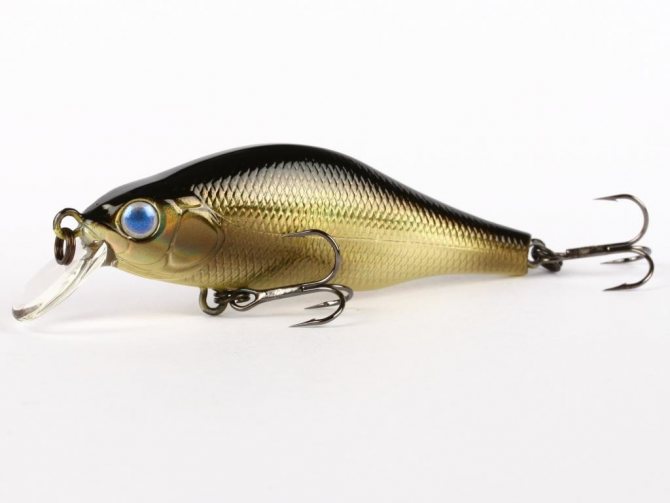
- Tsuribito Super Crank 50 and 60 SR. 5.6 cm and 7.12 grams, respectively. Another budget fatty that pike loves to eat. Creates a dull knock on the wire, which the pike likes. Good at depths up to 2 meters. Along oxbow lakes along water lilies, at medium depths in a slow current. In a fast current it falls on its side. The animation is uniform, uniform with pauses, twitch jerks of 15-20 cm with pauses of 1-3 seconds.
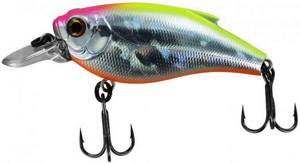
We also note the following models that were not included in the TOP 10, but are worthy of it:
- OSP BLITZ MR - depth up to 3 meters, weight under 10 grams, quiet.
- Megabass Deep X-300 is a deep-sea crank diver for pike, depth up to 6 meters.
- Megabass Deep X-100 - depth up to 2-3 meters.
- The Salmo Hornet is a budget aircraft, but the downside is that it flies very poorly.
- Rapala Shad Rap is another budget model, available in impressive sizes.
Where to use cranks?
Crank fishing, as mentioned above, is possible in different types of reservoirs. These baits work successfully on rivers with any current strength, are used in lakes, quarries, swamps and toad grasses, and show their best qualities when fishing in reservoirs.
In our latitudes, the main objects for fishing with crank wobblers are:
- perch;
- chub;
- pike;
- asp.
Deep-sea models capable of fishing channel holes and ditches are good for catching pike perch and catfish. Miniature wobblers regularly catch ide, rudd, dace, sabrefish and other representatives of the ichthyofauna. You can even catch bleak or roach with the smallest and weightless baits.
The best time for fishing with fats and other types of cranks is summer. During this period, the fish are most active and respond well to the aggressive behavior of wobblers. In cold water, bites occur less frequently, but still, if you present the bait correctly, you can return home with a decent catch.


